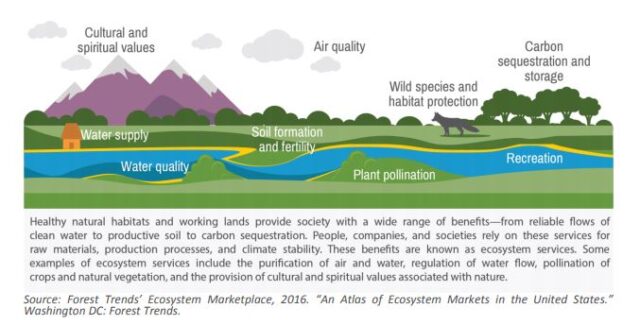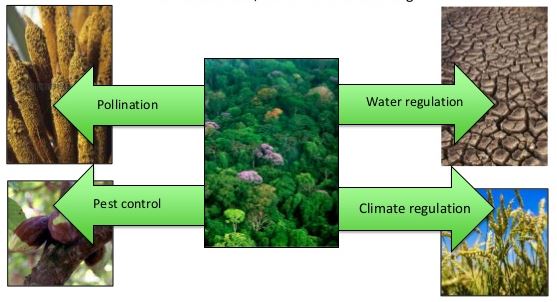By Manadilani Daluwatte – Trustee, Federation of Environmental Organisations, Sri Lanka (FEO)
“The death of the forest is the end of our life.”
Dorothy Stang
Why are forests important? This is a question that we must all focus on now, before it is too late, as much of Sri Lanka’s forests are being destroyed before our very eyes. Forests provide a number of ecosystem services that are fundamental to our very existence, even though they largely go unnoticed and unappreciated. These economic services are priceless, yet Mother Nature gives them to us for free.

Forests give us Life
When we breathe – the automatic bodily function we all do, keeping us alive, oxygen is absorbed through our lungs into our blood, and carbon dioxide exhaled out. This oxygen we breathe comes from forests and the oceans through photosynthesis. It has been estimated that one large tree can produce a day’s requirement of oxygen for up to 4 people. The more ancient the forest, the more efficient it is at this process.
Forests are the Best Defense against Climate Change
Forests act as ‘carbon sinks’; they trap and store carbon dioxide, which helps to clean the air and reduce the negative effects that an excess of it can have on our environment. 1/2 of all the carbon stored in the world’s forests, is found in tropical areas (State of the Rainforest).
As an island Sri Lanka stands to lose more than some other countries as a result of global warming, as rising sea levels can have disastrous consequences on small islands. Protecting our remaining forests is an active decision we take to mitigate how we are impacted by global warming.
Forests Protect Soil Quality and Stop Natural Disasters
Natural forest ecosystems create and conserve the health of soils by cycling nutrients, and storing water. By limiting water runoff and maximizing rainwater absorption, forests prevent land desertification and degradation as well as soil erosion. This process also minimizes the risks from natural disasters such as floods, landslides and droughts.

All wildlife species depend on healthy forests for their existence. Forests provide them with shelter as well as the food they eat like wild fruits, nuts and plants they need to thrive. These wild animals provide a great ecological service by spreading the seeds of the plants they eat, which in turn helps to fertilize the soil and keep it healthy – the same soil we rely on to grow our food. Many wild animals also help soil conservation by digging the earth, burrowing into the soil and loosening it, making it more porous. Their excreta helps replenish the nutrient content of the soil by providing it with enriching minerals.
Forests Create Rain and Cool the Atmosphere
The latest research confirms that trees and forests play an important element in a country’s rainfall patterns (Science Mag: Influence of Land-Surface Evapotranspiration on the Earth’s Climate Science).
When forests are cleared for agriculture, it lessens the amount of water which can evaporate from the soil and forests, resulting in reduced rainfall or in worse cases – drought. It is estimated that large-scale deforestation reduces rainfall in some areas by up to 30%.
Forests Sustain Agriculture
Source: Center for International Forestry Research (CIFOR)
Forests provide a major contribution for sustainable agriculture. Sadly, in Sri Lanka however, inadequate attention is given to this relationship. Instead, forests are being increasingly destroyed in order to expand largely inefficient farming practices.

Forests support sustainable agriculture by:
- Regulating the water-cycle and providing rain
- Cycling nutrients and making the soil fertile
- Stabilizing the climate and providing the right conditions for growing crops
- Protecting crops from droughts and floods
- Providing a habitat for pollinator species like bees, butterflies, other insects and fruit bats, etc – Pollinator species perform a crucial service that supports most of the world’s plant diversity – and a significant portion of global agriculture. It is said that 1/3 of every bite of food we eat is thanks to the services of pollinator species!
- Providing a habitat for natural predators of agricultural pests like insectivorous birds.

Therefore, destroying our forests for the sake of agriculture is like shooting oneself in the foot. It is not only counterproductive but will have long-lasting impacts on agricultural productivity all over
Sri Lanka.
Forests Create Biodiversity
“Tropical, temperate and boreal forests provide the most diverse sets of habitats for all types of life, together holding more than 80% of the world’s terrestrial species of animals, plants and insects.”
(https://www.un.org/sustainabledevelopment/biodiversity/)
Biodiversity, or diverse species of flora and fauna, is what makes a forest. There is such a close interconnection between the flora and fauna that one species cannot survive without the other; and we cannot survive without them all. Biodiversity is essential in maintaining a forest’s basic ecological processes
Forests also provide a storehouse of genetic material for the development of medicines to treat illness and disease. Recent estimates suggest that 3/4 of the top-ranking global prescription drugs contain components derived from plant extracts, many of which come from the world’s forests. (https://www.un.org/sustainabledevelopment/biodiversity/)
Forests Protect Us from Zoonotic Diseases
As we find out more about the Covid-19 pandemic, and the origins of the virus, it is very clear that it transferred to humans from wild animals, from our abuse of those species, and the destruction of their natural habitat. Healthy populations of wildlife, living in balanced forests and ecosystems, ensure that these hitherto unknown dangers are controlled and are contained within their specialized environments. Interfere with them, and let them loose, they will seek new hosts – us, in a way that the whole World reels from today.
Forests Generate Foreign Exchange Income
Wild animals require their natural habitats for survival. No more wildlife habitat = no more wildlife. Sri Lanka is well known as a country that ranks high in Asia, and the World, when it comes to wildlife tourism.
From all over the World, visitors come to Sri Lanka to see our elephants, leopards, snakes, butterflies and other exotic animals; 39% of all visitors to this country visit one or more of the National Parks. “The Gathering’ which happens annually in Minneriya is estimated to generate Rs. 1.5 Billion to the area. The booming economy at Uda Walawe is thanks to the wild elephants that can be seen there on any day of the year, at any time of the day. These wild elephants require large home ranges to seek food and water, and forests are essential to their existence. They use forest corridors to move between large wilderness areas such as wildlife parks and other protected areas. Blocking these corridors, and encroaching into Sri Lanka’s last remaining wildlife habitats, will not only affect the livelihoods of the communities reliant on wildlife tourism, but will risk many billions of rupees in foreign exchange to this country.
It Takes Hundreds of Years to Grow a Forest…yet it can be Cut Down in the Blink of an Eye
These are just some of the main benefits we, as humans, derive free from the forests; there are many, many more. Imagine if we had to pay for them? How much would the government of Sri Lanka have to spend to ensure the survival of the people? These are important questions that should be answered before it is all too late and before Sri Lanka’s last remaining true forests, which are a mere 17% of the land area, disappear forever.
The importance of forests cannot be underestimated. From the forest floor covered in leaf litter and a million crawling creatures to the tops of their tree crowns, forests are the real heroes keeping our country, and us alive.
To destroy Sri Lanka’s forests is to actively destroy Sri Lanka’s future.



